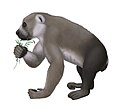Palaeopropithecidae

| Palaeopropithecidae[1] | ||
|---|---|---|
 Representación artística de Palaeopropithecus ingens | ||
| Taxonomía | ||
| Reino: | Animalia | |
| Filo: | Chordata | |
| Clase: | Mammalia | |
| Orden: | Primates | |
| Suborden: | Strepsirrhini | |
| Infraorden: | Lemuriformes | |
| Familia: | †Palaeopropithecidae | |
| Género | ||
Los paleopropitécidos (Palaeopropithecidae), conocidos como lémures perezoso, son una familia extinta de primates lemuriformes que incluye cuatro géneros.[1][2]
- Mesopropithecus globiceps
| Primates |
| ||||||||||||||||||||||||||||||||||||||||||||||||||||||||||||||||||||||||||||||||||||
Filogenia basada en las publicaciones de Horvath et ál. (2008) y Orlando et al. (2008).[4][5]
Referencias
[editar]- ↑ a b Mittermeier, Russell A., et ál. (2006). Lemurs of Madagascar (2ª edición). Conservation International. pp. 44–45. ISBN 1-881173-88-7.
- ↑ Nowak, Ronald M. (1999). Walker's Primates of the World. Johns Hopkins University Press. pp. 89–91. ISBN 0-8018-6251-5.
- ↑ Gommery, D.; Ramanivosoa, B.; Tombomiadana-Raveloson, S.; Randrianantenaina, H.; Kerloc’h, P. (2009). «A new species of giant subfossil lemur from the North-West of Madagascar (Palaeopropithecus kelyus, Primates)». Comptes Rendus Palevol 3 (5): 471-480. doi:10.1016/j.crpv.2009.02.001.
- ↑ Horvath, J.E.; Weisrock, D.W.; Embry, S.L.; Fiorentino, I.; Balhoff, J.P.; Kappeler, P.; Wray, G.A.; Willard, H.F. et al. (2008). "Development and application of a phylogenomic toolkit: Resolving the evolutionary history of Madagascar's lemurs". Genome Research 18 (3): 490.
- ↑ Orlando, L.; Calvignac, S.; Schnebelen, C.; Douady, C.J.; Godfrey, L.R.; Hänni, C. (2008). "DNA from extinct giant lemurs links archaeolemurids to extant indriids". BMC Evolutionary Biology 8 (121).


